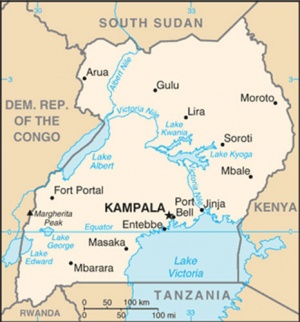Uganda Statistics
Introduction
This page links to the current online resources available to explore Uganda population and birth data.
| Statistics Links: Introduction | Reports | World Population | World Fertility | World Infant Mortality | Maternal Mortality | Australia | Brazil | Canada | China | Germany | India | Indonesia | Europe | Myanmar | Netherlands | Spain | United Kingdom | Romania | Uganda | United States | BGD Tutorial - Applied Embryology and Teratology | National Perinatal Statistics Unit | AIHW | Category:Statistics | |
|
General Statistics
- Population: 37,101,745 (July 2015 est.)
- country comparison to the world: 36
Birth rate
- 43.79 births/1,000 population (2015 est.)
- country comparison to the world: 3
Death rate
- 10.69 deaths/1,000 population (2015 est.)
- country comparison to the world: 36
Mother's
- Mother's mean age at first birth: 19.3 median age at first birth among women 20-24 (2011 est.)
- Maternal mortality rate: 343 deaths/100,000 live births (2015 est.) country comparison to the world: 37
Infant mortality rate
- total: 59.21 deaths/1,000 live births
- male: 68.39 deaths/1,000 live births
- female: 49.75 deaths/1,000 live births (2015 est.)
- country comparison to the world: 21
A description of congenital anomalies among infants in Entebbe, Uganda
Birth Defects Res A Clin Mol Teratol. 2011 Sep;91(9):857-61. doi: 10.1002/bdra.20838. Epub 2011 Jul 18.
Ndibazza J, Lule S, Nampijja M, Mpairwe H, Oduru G, Kiggundu M, Akello M, Muhangi L, Elliott AM.
Source MRC/UVRI Uganda Research Unit on AIDS, Uganda Virus Research Institute, Entebbe, Uganda. Juliet.Ndibazza@mrcuganda.org
Abstract
BACKGROUND: Data on congenital anomalies from developing countries of the sub-Saharan region are scarce. However, it is important to have comprehensive and reliable data on the description and prevalence of congenital anomalies to allow surveillance and the implementation of appropriate public health strategies for prevention and management. In this study, we describe the profile of congenital anomalies seen in a birth cohort in Entebbe, Uganda.
METHODS: Congenital anomalies were defined as any structural defect present at birth. Pregnant women were recruited to the cohort between 2003 and 2005. Defects present at birth were recorded by the midwife at delivery and by physicians at the routine six-week postnatal visit and at illness-related visits until 1 year of life. The anomalies were classified by organ system according to the 10th version of the World Health Organization International Classification of Diseases (ICD-10).
RESULTS: There were 180 infants with a congenital anomaly among 2365 births. The most commonly affected systems were the musculoskeletal (42.7 per 1000 births) and skin (16.1 per 1000 births). The prevalence of major anomalies was 20.3 per 1000 births; 1.7 per 1000 births for cardiac anomalies and 1.3 per 1000 births for neural system anomalies. Forty (22%) of the congenital anomalies were identified at birth, 131 (73%) at the 6-week postnatal visit, and nine (5%) at illness-related visits.
CONCLUSION: Congenital anomalies are common in developing countries. Establishment of comprehensive databases for surveillance would be helpful for surveillance of effects of new exposures, for prevention, management, and health care planning. Copyright © 2011 Wiley-Liss, Inc.
PMID 21770020
References
<pubmed>21770020</pubmed>
External Links
External Links Notice - The dynamic nature of the internet may mean that some of these listed links may no longer function. If the link no longer works search the web with the link text or name. Links to any external commercial sites are provided for information purposes only and should never be considered an endorsement. UNSW Embryology is provided as an educational resource with no clinical information or commercial affiliation.
- The World Factbook Uganda
Glossary Links
- Glossary: A | B | C | D | E | F | G | H | I | J | K | L | M | N | O | P | Q | R | S | T | U | V | W | X | Y | Z | Numbers | Symbols | Term Link
Cite this page: Hill, M.A. (2024, April 30) Embryology Uganda Statistics. Retrieved from https://embryology.med.unsw.edu.au/embryology/index.php/Uganda_Statistics
- © Dr Mark Hill 2024, UNSW Embryology ISBN: 978 0 7334 2609 4 - UNSW CRICOS Provider Code No. 00098G
